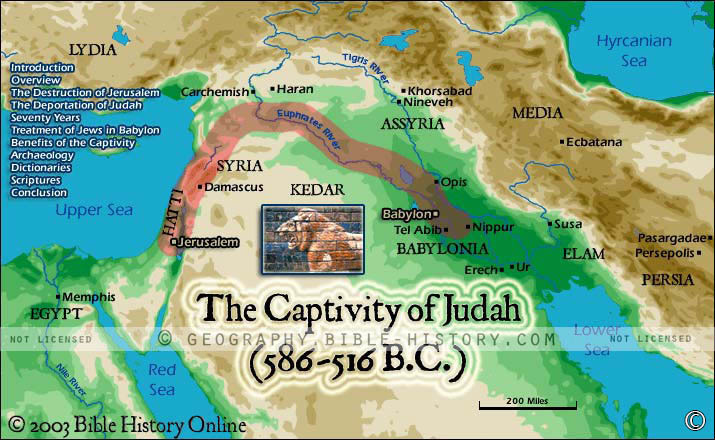
The map of the Captivity of Judah (586-516 B.C.) offers a profound visual representation of a challenging and transformative period in the history of ancient Israel. During this time, the people of Judah were exiled to Babylon, marking a significant chapter in their faith and identity.
Geographical Exile:
This map provides a detailed view of the geographical aspects of the Babylonian Captivity, highlighting the journey from Jerusalem to Babylon and the approximate locations where the Judean exiles were settled.
Routes and Destinations:
It outlines the routes taken by the exiles during their forced march to Babylon and the regions where they were dispersed. Key destinations such as Babylon, the Euphrates River, and the cities of exile are marked.
Exilic Communities:
The map showcases the locations where Judean exiles established communities during their captivity. These communities became centers of Judean life, culture, and faith during their time in Babylon.
Life in Exile:
It may include depictions of the daily life, culture, and religious practices of the exiles in Babylon, shedding light on how they adapted to their new surroundings and maintained their faith.
Return to Jerusalem:
The map may indicate the return journey of some exiles to Jerusalem after Cyrus the Great's decree, which allowed the rebuilding of the Temple and the restoration of Jewish worship.
Temple Reconstruction:
It may feature the construction of the Second Temple in Jerusalem, a significant religious and cultural achievement that marked the end of the exile period.
Cultural and Religious Continuity:
The map reflects the continuity of Judean culture, language, and religious practices during the captivity, as well as their preservation of sacred texts and traditions.
Prophetic Messages:
It can highlight locations associated with the prophetic messages of figures like Ezekiel, who provided guidance and hope to the exiled Judeans.
Historical and Political Context:
The map provides historical context, including the changing political dynamics in Babylon and the role of Persian rulers in the eventual return of the exiles to Judah.
The map of the Captivity of Judah (586-516 B.C.) invites viewers to explore a transformative period in the history of the Jewish people. It provides a visual representation of the geography, exile experience, and the eventual return to their homeland, deepening the understanding of the biblical narrative and the enduring faith and resilience of the Judean exiles.
Blank Topo Map of The World
Abraham’s Journey
The Captivity of Judah (586-516 B.C.)
The Fall of Judah 586 B.C.
The Northern Kingdom of Israel
The Southern Kingdom of Judah
The Divided Kingdom
The Fertile Crescent
Ur of the Chaldees
Shechem in Old Testament Times
Prophets, Kings, and Nations
Jesus Last Passover
New Testament Israel
New Testament Places
Old Testament Israel
Provinces of the Roman Empire
Israel during David’s Kingdom
David’s Kingdom
Cities of the New Testament 4
Cities of the New Testament 3
Cities of the New Testament 2
Mediterranean Sea
Cities of the New Testament
First Century Jerusalem
Empire of David and Solomon
David’s Kingdom
Israel Under Rehoboam
Ophir and Tarshish
The Period of the Kings
Ramoth Gilead
Samaria
Solomon’s Temple
Zarephath and MT Carmel
Jabesh Gilead and Tribes
Judah in the Time of David
Kingdom of Saul
Kirjath Jearim
Michmash
Mount Gilboa in the Time of David
Nob Davids Flight
Shiloh
Israel and Judah
Assyrian Empire Under Esarhaddon
Assyrian Empire Under Sennacherib
Captivity of 10 Tribes
Events in 2 Kings
The Khabur River
Israel and Syria
Captives From Judah
Kingdom of Jeroboam
Mesha’s Kingdom
Pharaoh Necho Battles King Josiah at Megiddo
Babylonian, Mede and Persian Empires
Samaria and Nearby Territories
Syria at its Height
Hebron
Mahanaim
1949 Map of Israel With Boundaries
First & Second Journeys of Paul
Journeys of the Apostles
Paul’s Third Missionary Journey
Saul’s Journey to Damascus and Arabia
Paul’s Final Visits
Paul’s 1st Missionary Journey
Paul’s 2nd Missionary Journey
Paul’s 3rd Missionary Journey
Paul’s Voyage to Rome
Phillip Journeys to Samaria and Gaza
Judah at the Time of Amos
Empire of Alexander the Great
Israel Under the Maccabees
Galilee During Maccabees
Idumea Intertestamental Period
Kingdom of the Ptolemies
Kingdom of the Seleucids
Ptolemaic Egypt Seleucid Asia
The Roman World
Kingdom of Ptolemies and Seleucids
The World During the 6TH Century BC
Mount Horeb
The Red Sea
The Exodus
Ezra’s Journey to Restore Jerusalem
Israel and Judah During Hosea’s Time
The Ancient World
Canaan During the Time of Abraham
The City of Shechem
Supposed Location of the Garden of Eden
The Land of Israel in Genesis
The Jordan River
The Kingdom of Nimrod
Mount Ararat and Mesopotamia
The Descendants
Sodom and Gomorrah
The Kingdom of Egypt
The Hamites
The Kingdom of the Hittites
Ur of the Chaldees
Judah at the Time of Haggai
Jesus Passes Through Samaria
